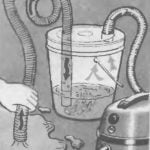 At the world Cup 1978, held in the city of Yambol (Bulgaria) in the class RC raketoplana S-4-D (the maximum mass of 240 g, the total impulse of the propulsion system 10-40 n*s) a convincing victory was won by the American athlete Harold Anglin. In three rounds, his model flew for 5 min in the fourth, additional, 3 min 23 s.
At the world Cup 1978, held in the city of Yambol (Bulgaria) in the class RC raketoplana S-4-D (the maximum mass of 240 g, the total impulse of the propulsion system 10-40 n*s) a convincing victory was won by the American athlete Harold Anglin. In three rounds, his model flew for 5 min in the fourth, additional, 3 min 23 s.
The fuselage of the model (see figure) glued balsa veneer thickness of 1.5 mm for increased durability equipped with seven frames. His nose is rectangular in cross-section shape, the tail boom goes into the triangle.
The procedure of manufacturing the fuselage is. Pre-prepared template to cut two sides. Between them in the fore part three: glue the frame, the rest hook to boom. Then glue the top and bottom plates (the latter will provide a cutout for access to the on-Board equipment). It is convenient to close the lid on linen hinges.
Pylon glued in front of the fuselage, above. To it glue glued container engine, stranded on the mandrel of the three layers of paper. During training flights the constructor has equipped two container guides from the pine strips that protect the space Shuttle. Without them fire back exhaust engine sometimes clung brake parachute for the wing and could completely destroy the model.

Model rocket glider world champion J. Harold:
1 — the fairing 2 — the container for the engine, 3 — guide ring, 4 — wing, 5 — stabilizer, 6 — Elevator, 7 — rudder 8 rudder bracket, 9 — bracket of the Elevator, 10 — pull rudder, 11 — Kiel, 12 — pull of the rudder 13 fuselage, 14 — rails shooting engine, 15 — pylon for attaching the container to the engine.
Wing — PLANO-convex profile with maximum thickness in the center section of 11 mm. this is how it is the right thing to do. Mold polyurethane foam core and glue it balsa veneer with a thickness of 1 mm. the Design is very durable and lightweight. To the top plate of the fuselage the wing is attached to the glue.
The stabilizer and fin — balsa plates 1.5 mm thick. Handlebars rotation and height, hung on plain hinges. Thrust wheels — steel wire Ø 1,2 mm.
The rocket plane starts one engine total impulse 35 n*s and a weight of 87 g. it is running — 7, slowing — 3.
To control the model applied a miniature two-channel receiver for four teams (left and right, up and down) weight (with meals) 75 g
The mass of the rocket at take-off 226 g.
V. ROZHKOV, master of sports of the USSR



